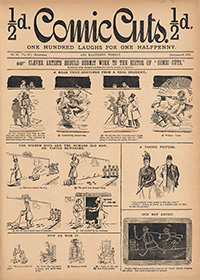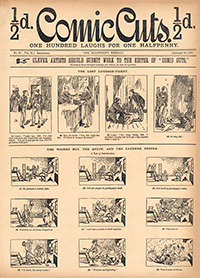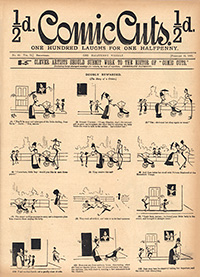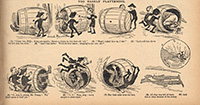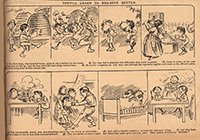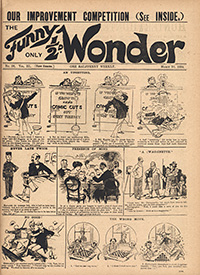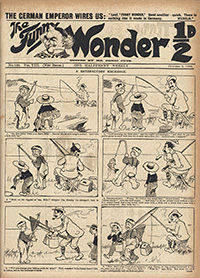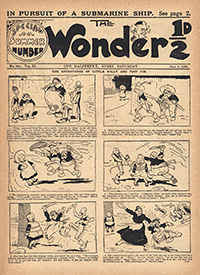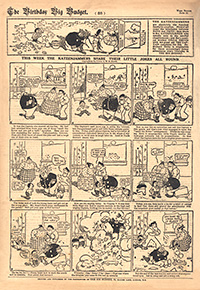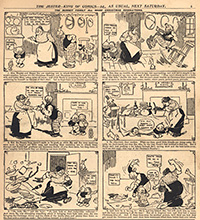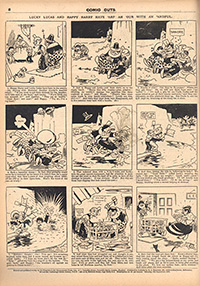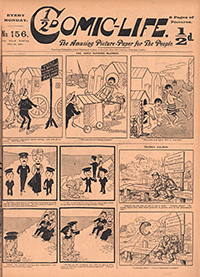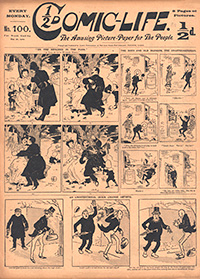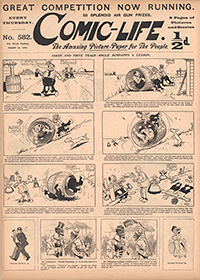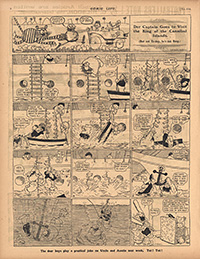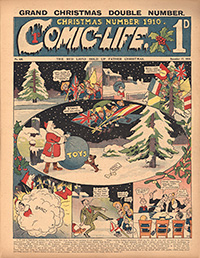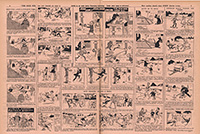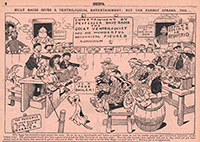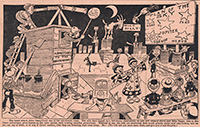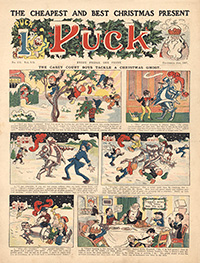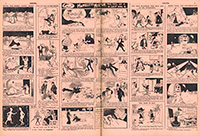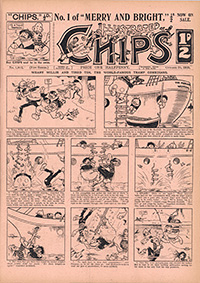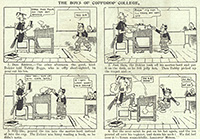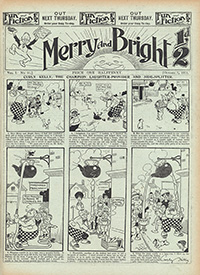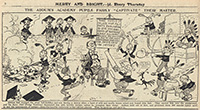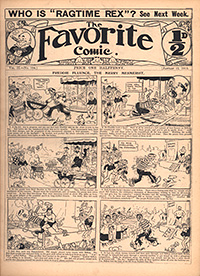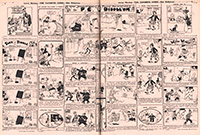Exhibit C1
Comic Cuts, London: “Answers” Company [Alfred Harmsworth]. Vol. 2, no. 30. 6 December 1890.
The cover page has three four-panel sets plus two cartoons, including two “naughty boy” strips: “A Mean Trick, more
Exhibit C2
Comic Cuts. London: Pandora Publishing Company [Alfred Harmsworth]. Vol. 2, no. 37. 24 January 1891.
The front page of Comic Cuts now has just two comic strips, one of the tricksters tricked variety more
Exhibit C3
Comic Cuts. London: Pandora Publishing Company [Alfred Harmsworth]. Vol. 2, no. 40. 14 February 1891.
“Doubly Rewarded (The Story of a Crime)”, a full-page, cover-page, street urchin strip in 12 panels. more
Exhibit C4
Comic Cuts. London: Pandora Publishing Company [Alfred Harmsworth]. Vol. 3, no. 58. 20 June 1891.
Wilhelm Busch’s philosopher is here turned into a tramp being tormented by urchins in this recasting “Diogenes and the Naughty Boys of Corinth” more
Exhibit C5
Comic Cuts. London: Pandora Publishing Company [Alfred Harmsworth].Vol. 3, no. 60. 4 July 1891.
Two weeks later Comic Cuts had an 8-panel Vandyke Browne version of Wilhelm Busch’s picture story “The Little Honey Thieves” more
Exhibit C6
The Funny Wonder. London: 24 Tudor Street [Harmsworth Bros.]. Vol. 3, no. 69 (new series). 26 May 1896.
“A Story with a Moral”, a six-panel strip based on Wilhelm Busch’s picture story “The Little Honey Thieves”. more
Exhibit C7
The Funny Wonder. London: 24 Tudor Street [Alfred Harmsworth]. Vol. 3, no. 58 (new series). 10 March 1894.
“An Upsetting”, a four-panel strip featuring “mischievous Billy and artful Jimmy”. more
Exhibit C8
The Funny Wonder. London: 24 Tudor Street [Harmsworth Bros.]. Vol. 8, no. 192 (new series). 3 October 1896.
The above full-page fishing adventure is not signed, but it is possible that Tom Browne took over the Billy and Jimmy characters for this front-page strip. more
Exhibit C9
The Wonder.Special Summer Number. London: 24 Tudor Street [Harmsworth Bros.]. Vol. 11, no. 284. 9 July 1898.
The cover page has the first instalment of “The Adventures of Little Willy and Tiny Tim”, the delinquent offspring of the “world-famedtramps”, more
Exhibit C10
The Birthday Big Budget. London: 28 Maiden Lane [C. Arthur Pearson]. Vol. 13, no. 313. 13 June 1903.
The Katzenjammer Kids, courtesy of American newspaper magnate W. R. Hearst, were drawn by Rudolph Dirks, who originally created them in 1897. more
Exhibit C11
The Grand Christmas Number of the Jester and Wonder. London: Lavington St. [Amalgamated Press]. No. 159. 26 November 1904.
On page 5, Ferdy and Georgie, otherwise known as The Bunsey Boys, an unabashed fusion of the Katzenjammer Kids and the Happy Hooligan. more
Exhibit C12
Comic Cuts. London: Amalgamated Press. No. 800. 9 September 1905.
Lucky Lucas and Happy Harry take on what seems to be an easy baby-sitting job, looking after Lucky’s twin nephews. more
Exhibit C13
Comic-Life. London: James Henderson & Sons. No. 156. 22 June 1901.
The cover page of Comic-Life (with a hyphen at this time) has three short strips featuring unruly boys, more
Exhibit C14
Comic-Life. London: James Henderson. No. 100. 26 May 1900.
A boy spoils an amorous policeman’s fun (4 panels), while a coastguard gets his revenge on two boys who have annoyed him (6 panels) more
Exhibit C15
Comic-Life. London: James Henderson & Sons. No. 582. 14 August 1909.
Set somewhere in Holland, this six-panel strip features young rascals Jakey and Fritz, also their drunken uncle, more
Exhibit C16
Comic-Life. James Henderson & Sons. No. 641. 1 October 1910.
Hans and Fritz, better known as the Katzenjammer Kids, originally drawn by Rudolph Dirks for American newspaper magnate W. R. Hearst’s publications. more
Exhibit C17
Comic-Life. Christmas Number 1910. London: James Henderson & Sons. No. 652. 17 December 1910.
Some good boys: “The Red Lions”, a humorous boy scout series, had originally started out as a prototypical adventure strip, more
Exhibit C18
Illustrated Chips. [London]: Lavington Street [Amalgamated Press]. Vol. 27, no. 684 (new series). 10 October 1903.
The silly antics presented on the centre pages of Chips at this point doubtless appealed more to children than to adults. more
Exhibit C19
Illustrated Chips. [London]: Lavington Street [Amalgamated Press]. Vol. 28, no. 751 (new series). 21 January 1905.
Casey Court, a tenement courtyard controlled by street urchins, appeared as a large-format cartoon in Chips from 24 May 1902 to 12 September 1953 in 2385 episodes, more
Exhibit C20
Illustrated Chips. [London]: Lavington Street [Amalgamated Press]. Vol. 28, no. 703 (new series). 20 February 1904.
For this week’s cash-generating venture, Billy Baggs and friends have rigged up a “full-blown observatory” more
Exhibit C21
Puck. London: B. W. Young [Amalgamated Press]. Vol. 7, no. 178. 21 December 1907.
The Casey Court Boys (soon to be called simply The Casey Boys) have now graduated from the black-print, cartoon-like panel on the centre pages of Chips more
Exhibit C22
Illustrated Chips. London: 25 Bouverie Street [Amalgamated Press]. No. 959 (new series). 16 January 1909.
These Chips centre pages have a number of short strips that would appeal to child readers: Dr. Swishem’s; Bobby Bang the Drummer Boy; more
Exhibit C23
Illustrated Chips. London: 25 Bouverie Street [Amalgamated Press]. No. 1052. 29 October 1910.
Weary Willie and Tired Tim devise a plan to kidnap the twin sons of American millionaire “Mr. Rockbilt, the hair-oil king” only to find the boys are more than their match in trickery. more
Exhibit C24
Merry and Bright. London: 25 Bouverie Street [Amalgamated Press]. Vol. 1, no. 39. 15 July 1911.
The first set in the new school series “The Boys of Coffdrop College” drawn by Bertie Brown. more
Exhibit C25
Merry and Bright. London: 25 Bouverie Street [Amalgamated Press]. Vol. 1, no.51. 7 October 1911.
Curly Kelly, “The Champion Laughter-Provider and Side-Splitter”, often finds himself surrounded by children, usually boys. more
Exhibit C26
Merry and Bright. London: Fleetway House [Amalgamated Press]. Vol. 3, no. 179. 21 March 1914.
“Addum’s Academy” (by Julius Baker, beginning 1913) is a single large Casey Court-style panel. more
Exhibit C27
The Favorite Comic. London: Fleetway House [Amalgamated Press]. Vol. 2, no. 104. 11 January 1913.
Freddie Fluence, a “good boy” who nevertheless creates mayhem, uses his remarkable hypnotic gift to compel grumpy or abusive adults to make amends for their bad behaviour. more
Exhibit C28
The Favorite Comic. London: Fleetway House [Amalgamated Press]. Vol. 3, no. 145. 25 October 1913.
The dense centre pages of this period had an obvious appeal to child readers. more
